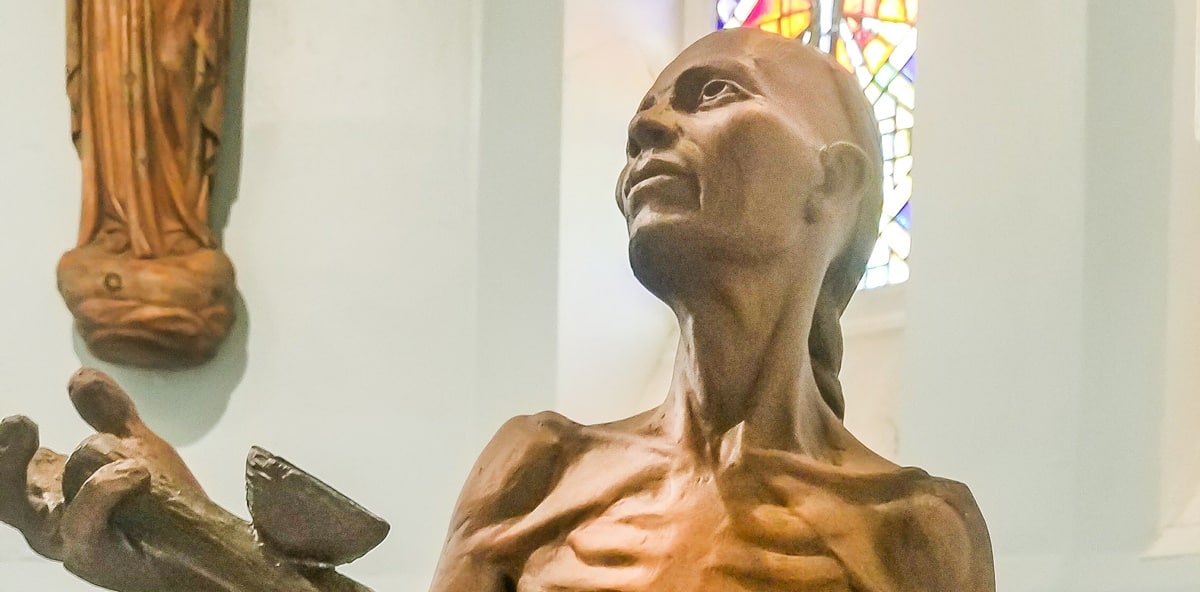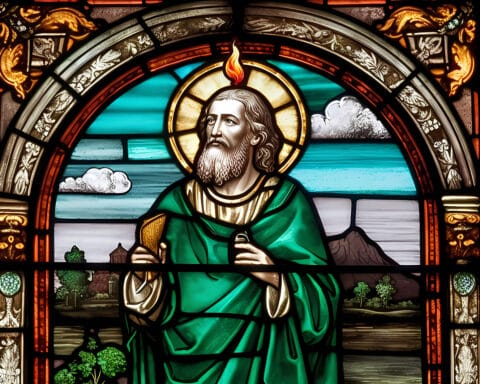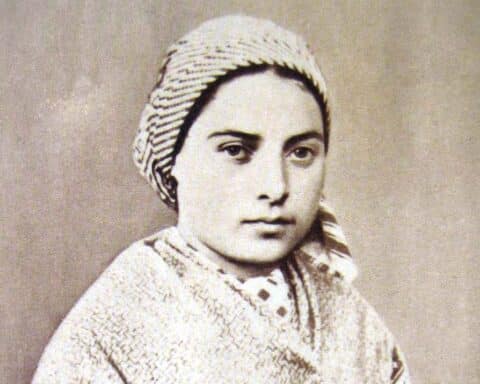The opium pipe rests in the half-open hands of St. Mark Ji Tianxiang, who looks up to heaven, as if to plead, “Please, take this away from me.”
“He holds it out in a sort of way like, ‘I don’t want this thing,'” said Erik Durant, a Massachusetts-based artist who designed a striking sculpture of the 19th-century Chinese layman who died as a martyr in 1900.
Durant told Our Sunday Visitor that he created the sculpture a few years ago after a local parish priest reached out to him. Biographical details were scarce.
“Basically all I got was the timeframe when he lived, that he was a known opium user for over 30 years and that because of the drug usage, he never received Communion yet continued to regularly go to church,” Durant said.
Father David Deston, a priest of the Diocese of Fall River, Massachusetts, saw in St. Mark Ji a symbol of hope for people struggling with drug addiction.
“His story is amazing, just absolutely amazing,” Father Deston said. “It’s one that I think should be out there more.”
| St. Anne Church and Shrine |
|---|
| St. Anne Shrine at 818 Middle Street in Fall River, Massachusetts, houses the statue of St. Mark Ji Tianxiang. The main church was closed in May 2015 when a large piece of plaster fell off the wall during a Mass. The church ceased to be a diocesan parish when it closed Nov. 25, 2018. The St. Anne Preservation Society is raising funds to stabilize the building and restore the building as a shrine. The Diocese of Fall River and the St. Anne’s Preservation Society entered into an agreement on July 1, 2019, through which the shrine will be under the care and oversight of the society. The basement shrine reopened July 4. Masses will be celebrated a minimum of twice per year. The shrine is open Monday through Sunday, 8 a.m. to 5 p.m. for the recitation of the Rosary, Bible study and special programs. |
Denied the Eucharist
St. Mark Ji Tianxiang struggled with opium addiction for almost half of his 66 years of life. A committed Catholic, he continually confessed to smoking opium, but the graces of the sacrament were not enough to deliver him from his addiction.
“He was definitely hooked. He was hooked on what was essentially a pure form of heroin for decades,” said Michael Rayes, a Catholic counselor in Phoenix.
St. Mark Ji’s confessor — without the benefit of modern science that has revealed drug addiction to be a disease that changes brain chemistry — eventually withheld absolution because he did not believe that St. Mark Ji had a firm purpose of amendment to stay away from the opium pipe.
For the last 30 years of his life, St. Mark Ji was denied the reception of the Eucharist, but he still grew in holiness.
“He never gave up, even when he couldn’t really have a full sacramental experience,” Rayes said. “I’m sure he made plenty of spiritual communions, and that must have hurt his heart.”
Believing that martyrdom was his only way to heaven, St. Mark Ji prayed for and received the martyr’s crown when he was killed during the anti-Christian persecutions of the Boxer Rebellion.
“Here, you have St. Mark Ji, who stops receiving the Eucharist, and yet he’s still a saint who was growing spiritually,” said Dr. Gregory Bottaro, executive director of the Catholic Psych Institute, a Catholic psychology practice based in Connecticut.
Bottaro told Our Sunday Visitor that St. Mark Ji’s complicated life challenges modern Catholics to think deeper and “outside the box” about the Communion of Saints, life, holiness, the sacraments and the Catholic faith itself.
“It’s stories like his that help to recalibrate our sense of humanity and our relationship with God,” Bottaro said.
Gripped by addiction
The short official biographies indicate that St. Mark Ji Tianxiang was born in 1834 in the apostolic vicariate of Southeastern Zhili, China. He was raised in a Christian family and grew up to become a physician and a respected member of his community.
As a doctor, St. Mark Ji served the poor for free. However, in his mid-30s, he became ill with a serious stomach ailment and treated himself with opium, which was a common pain medicine, but it was but highly addictive.
St. Mark Ji soon was gripped by opium addiction, which in 19th-century China was considered to be shameful and a grave scandal. Similar to how heroin addicts today often are reviled and called junkies, opium addicts then in China were scorned.
Black-and-white photos of Chinese opium addicts from the late 1800s show they were often gaunt, with hollowed-out eyes, sunken cheekbones and the outlines of their rib cages clearly visible through the skin.
“They’re all emaciated and almost skeletal looking,” said Durant, who studied 19th-century photographs of Chinese opium addicts to get an idea of how St. Mark Ji may have looked after 30 years of smoking opium.
“I basically came up with an amalgamation,” Durant said. “I used my knowledge of anatomy and had a model pose for a general gesture. I basically stripped the muscle off that person in order to come up with an image.”
St. Mark Ji prayed for deliverance, but the chains of addiction were never removed from him. Still, he fought it, frequently going to confession. But after a few years, the priest to whom St. Mark Ji confessed told him to stop coming back until he was serious about stopping his sin.
“One of the elements that struck me about his story was his support system did not understand his addiction, and essentially they rejected him,” said Rayes, who chose St. Mark Ji as the patron for his counseling practice, Intercessory Counseling & Wellness in Phoenix.
Today, priest-confessors have the benefit of modern science and psychology when it comes to understanding that drug addiction is a disease. In light of that understanding, Bottaro said the Church is “constantly developing” in its application of eternal truth.
“Obviously, truth doesn’t change, but the depth of understanding matures,” Bottaro said. “And here you have a perfect example where we didn’t have the sort of human understanding of science, from brain science studies and social psychology, of understanding the effect of drugs and understanding what’s happening in the brain.”
Being denied access to the sacraments and shunned by one’s community would arguably be enough to discourage most people from wanting to be involved with the Church. But St. Mark Ji remained a practicing Catholic, even if he could not beat his addiction.
“The Church, his confessors, didn’t understand the nature of addiction, and yet he persevered in his faith,” Rayes said. “So that, I think, is a really strong example for those today who are struggling with addiction, because you can feel so alone.”
“He did what he thought was the right thing to do,” Father Deston added. “He struggled to live a good life. He attended Mass regularly. He never stopped believing in God’s mercy. I think his martyrdom just grew out of his own faith. It wasn’t a means to an end for him.”
Martyrdom
Between 1899 and 1901, toward the end of the Qing dynasty, the Boxer Rebellion broke out in China as Chinese nationalists cracked down against foreigners and Christians. During the two-year uprising, more than 32,000 Chinese Christians and 200 foreign missionaries were massacred.
In 1900, the Boxers arrested St. Mark Ji, rounding him up with dozens of other Christians, including his son, six grandchildren and two daughters-in-law. At trial, St. Mark Ji was given the opportunity to apostatize, but he refused.
He was led to his execution with the other members of his family on July 7, 1900. He begged his captors to kill him last so that none of his relatives would die alone. As he awaited his own death, he sang the Litany of the Blessed Virgin Mary.
“When we have this story of St. Mark, it’s so out there that that’s it’s almost impossible to tidy it up and make it neat and pretty for a little prayer card,” Bottaro said. “His story is so central on the messiness of his life that you can’t avoid that aspect of it.”
Sainthood
Pope Pius XII beatified St. Mark Ji along with 120 other Chinese martyrs on Nov. 24, 1946. St. Pope John Paul II canonized him on Oct. 1, 2000. His feast day is July 7.
In more recent years, St. Mark Ji’s life story has resonated with many who have been affected by the national opioid crisis. According to the National Institute on Drug Abuse, more than 130 people in the United States die each day after overdosing on opioids.
For many today who suffer from drug addiction, and people who see their loved ones struggling with the disease, St. Mark Ji has become a patron.
“People would leave notes by his statue. Occasionally, I would straighten them up and read them. Many of them were just heartbreaking, where people were talking about their own struggles or asking for prayers for their loved ones,” said Father Deston, who had the statue of St. Mark Ji placed in his former parish’s basement shrine.
Durant said a priest in Pittsburgh called him and asked for a copy of the sculpture. Employees from an addiction center in New Hampshire traveled to St. Anne Shrine in Fall River, Massachusetts, to see the statue.
“I think he’s a fascinating and important character,” Durant said.
“Drug addiction, then or now, is one of the issues of our time,” Durant said. “It’s so big, affecting so many people. It affects all ages, races, socioeconomic status. It affects all of us. It’s important, whether you’re Catholic or not.”
Brian Fraga is a contributing editor for Our Sunday Visitor.





